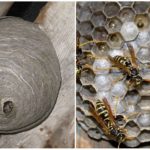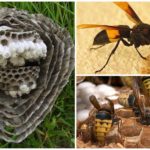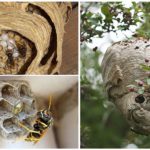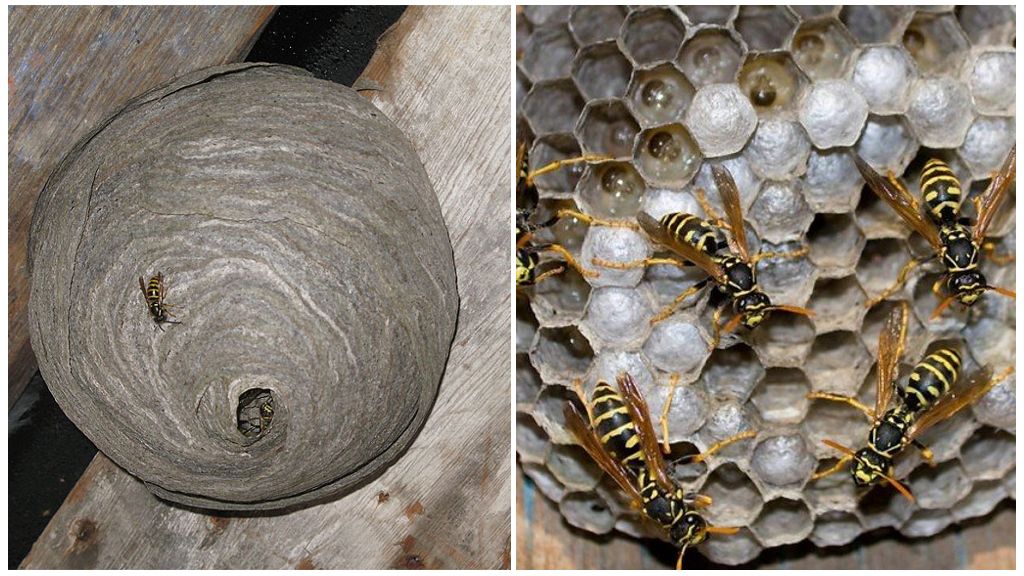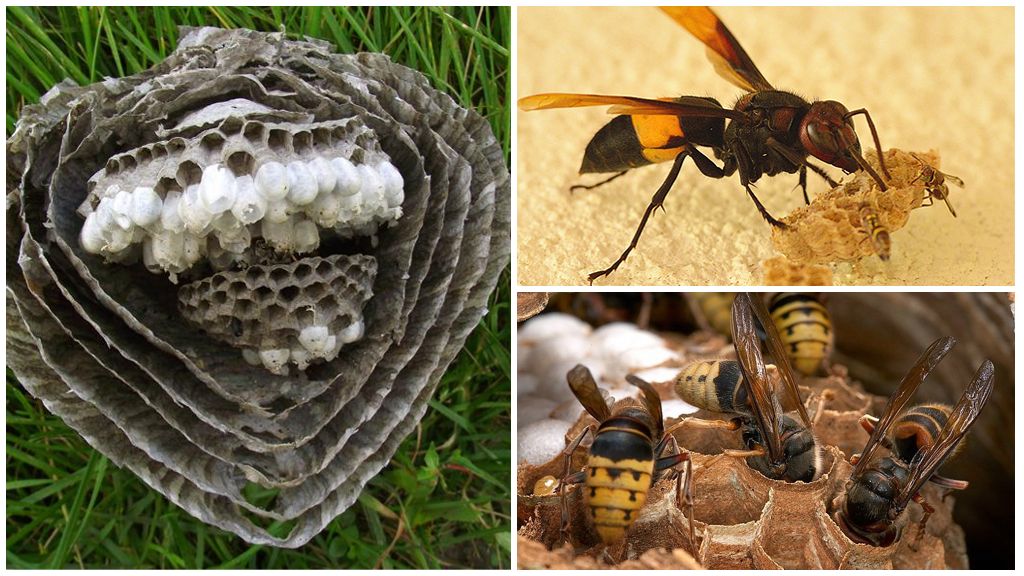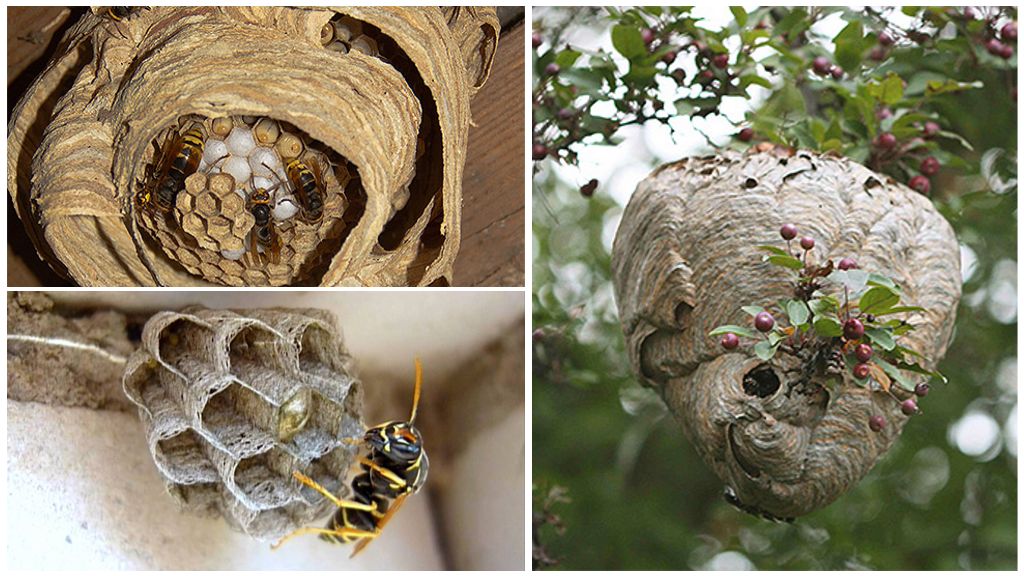How and what wasps make nests
Content
- Vespiary
- Hornet's nest in section
- Wasps nests
The photo of the wasp nest impresses with the complexity of its structure, equipment, and materials. In a huge "architectural building" can accommodate about 1 million. Individuals. The construction functions are assigned to a specific caste of workers. wasp. The hornet’s nest expands as the family grows. In most cases, the wasps return to their former home after wintering, laying the beginning of a new family.
Construction material
The finished nest wasps can not fail to impress. From the outside, it looks like a smooth, oval-shaped egg. Inside, there are numerous cells located in a certain way. The building material resembles ancient parchment. Mostly gray, brownish color. Because of how the wasps build their nest, they are called paper wasps. The family is one of the most numerous, includes species, subspecies.
What the wasps make nests for and how the building material is mined is also worthy of respect. The insect sits on the wood, spits a certain amount of its own secret, under the influence of which the upper bark tissues are liquefied. The wasp catches the upper layer with powerful jaws, pulls on itself, as if scraping. When the necessary quantity is typed to it, goes to the place where other relatives do a beehive.
Arriving at the right place, the wasp once again carefully chews the building material with its jaws. Under the influence of saliva, the wood becomes sticky, viscous, gray or brown, depending on which tree it was extracted from. The wasp spits out the finished building material on the already formed honeycomb, again stretches the jaws, giving its structure an oval shape. So there is a new thin partition.
Interesting!
The wood elements of the wasp are extracted from the bark of various trees, stumps, fences, wooden household structures. If the building material is not enough or the uterus finds a place suitable for growing larvae, wasps build a nest under the ground, in old stumps, hollows, left bird houses.
Construction process
Fertile young chooses a place for their future housing female uterus. It sticks a sticky substance extracted from wood to the base, stretches it, and a leg is formed, on which the first honeycombs are subsequently built. Initially, they are very few, necessary for growing, feeding the larvae.
The process begins in early spring. Within a month, a new generation of working wasps appears, which are starting the active construction of the hive. The uterus relinquishes the authority of the architect, deals only with procreation.
- The hornet’s nest is being built at a heightened pace, as the number of members of a large family is rapidly increasing. At the base of the handle there are new cells that overlap each other, form a honeycomb.
- As the number of cells increases, the shape of the structure in the form of a bowl begins to emerge. Over time, it increases in depth, expands on all sides, and becomes like a sphere. In the center is a hole for entry.
- The structure of the second part of the sphere begins gradually. The number of cells decreases to the top. The finished big wasp nest resembles a cocoon.
After completion of construction, the uterus removes several layers of internal cells in the first sphere. As the wasps make honeycombs wide, the space inside is released. The outer shell of the socket is thin, paper. Formed from long, thin, elastic plates. In most cases, recycled construction material is used, which is taken after the destruction of the inner layers of the hive.
What does a hornet's nest look like from the inside
The internal structure is fun, thoughtful, amazing. Honeycombs are placed vertically in original floors, after every 3-6 rows there is free space. It is also surprising that all cells are directed down to one side. A photo of the wasp nest in the section can be seen below. You can cut a hive only if you are sure that it is empty.
Interesting!
The average typical structure of a wasp does not exceed the size of an apple. In some cases, the giant round wasp nests expand to incredible dimensions. In diameter equal to 1 m. Wasps in an aspen nest of incredible sizes read several thousand, up to a million.
The hive device is thought out to the smallest detail. The interior is always the most durable, reliable. Honeycombs are not built from a thin sticky secret, similar to paper, but from wood chips, in such a size that workers can carry away, to attach. Inside the wasp nest there are cameras for the larvae, a room for the uterus, storerooms for food and much more.
Wintering place
Looking at the internal, external structure of the wasp nest, it seems that the family will spend more than one year there. Just as it happens in ants. However, large buildings, complex architectural buildings play the role of a summer house.
With the onset of autumn, young mature females mate, begin to look for a suitable place for wintering - cracks in the wall, wooden buildings, bark of trees, old stumps, abandoned hollows.Over time, metabolic processes slow down, the female falls into anabiosis, and sleeps until the beginning of spring. From the first warm days begins to build a new hive.
On a note!
The rest of the family die in the fall from cold or become victims of natural enemies. They lose their former activity, become slow, vulnerable. At the end of the season, the old uterus, workers, and males are killed.
Where do wasp nests are built
The young uterus chooses a place where there is a building material, food reserves in the immediate vicinity. In the wild, insects develop housing on a tree with a large, dense crown, under old stumps, abandoned bird houses. However, there are cases of the structure of the hive under a stone, on a blade of grass. Where a young female will consider it necessary to build housing, working individuals will continue to build there.
Insects can build a hive near a person - under the roof of a house, economic wooden extensions, in the attic, balcony, live in the garden, yard, vegetable garden, vineyard. And also on trees, bushes, old stumps on the site. If in the wild nature, wasps bring many benefits, destroy harmful insects, in the territory of a garden, suburban area, yard, they become real pests. Therefore, a person is trying get rid of wasps of other nests on the balcony, in the country, vineyard.
On a note!
Angry wasp is very simple. Just a few sudden movements, as she rushes to attack. During an attack, it makes special sounds — signals, warns other members of society of the danger, and also calls for help. If there is a nest nearby, a whole swarm can attack.
Methods of struggle
To get rid of the wasp nest on the land plot, it is poured with boiled water or poured with combustible matter, set on fire. The procedure is performed in the late evening, when all members of the family are assembled, are going to sleep, or in the early morning, when they have not yet had time to scatter.
When placing the hive under the roof of the house, in the attic, a tree, the nest is immersed in water. Fill the bucket, bring it neatly to the wasp nest, immersed in water. Another modern way pest control - use of a vacuum cleaner. Tighten all the power of insects in the bag, then throw into the water.
In order to prevent the construction of nests, repellent plants - mint, lemon balm, marigold, calendula are planted on the land plot. Walls treated insecticide substance, paint, varnish, boric acid solution.

